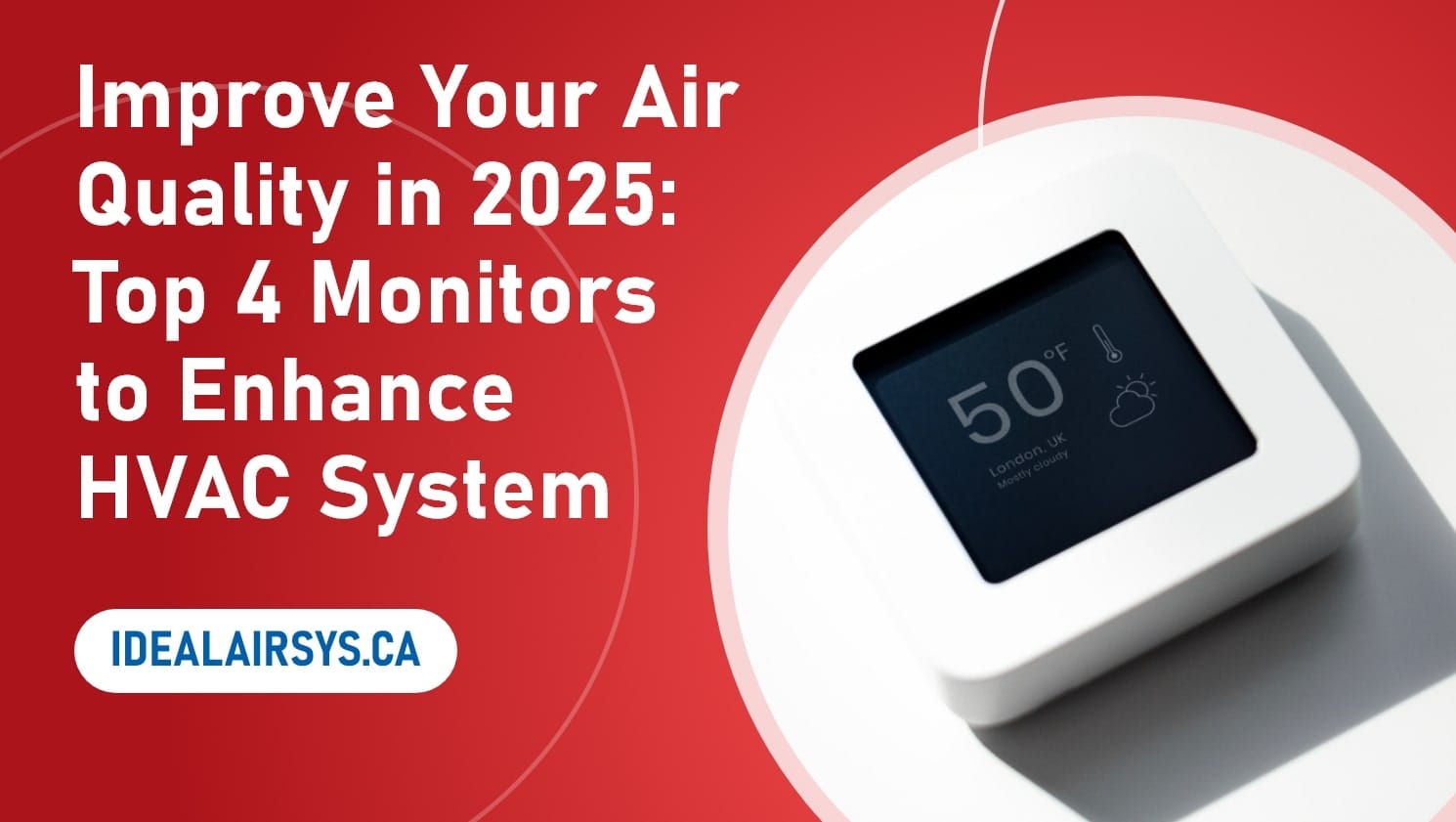
Are you breathing the clean air your home deserves? In today’s world, maintaining excellent indoor air quality is more crucial than ever. At Ideal Air Systems, we understand the importance of fresh, healthy air in your home. This article delves into the essentials of Air Quality Monitoring, exploring its significance in your HVAC system and how it can transform your living environment.
Here’s what you’ll discover:
- What is Air Quality Monitoring? Learn how these monitors work and their vital role in enhancing your home’s HVAC system.
- Choosing the Right Monitor: Discover the key factors to consider when selecting an air quality monitor that best fits your needs.
- Top Picks for 2025: Explore our expert recommendations for the four best air quality monitors available this year.
If you’re ready to breathe easier and optimize your home’s comfort, keep reading to uncover everything you need to know about air quality monitors and how they can benefit your home in the Greater Toronto Area. On the below section, you can listen an conversation-based podcast about this article.
Table of Contents
What Are Air Quality Monitors? Enhancing Your Home’s Environment
Air quality monitors are innovative devices that play a pivotal role in ensuring the air you breathe indoors is clean and safe. An air quality monitor utilizes one or more sensors and advanced components to detect, monitor, and report on specific air pollutants such as particulate matter (PM), carbon dioxide (CO₂), and other environmental factors like temperature and humidity.
At Ideal Air Systems, we understand that maintaining optimal indoor air quality is essential for your health and comfort. Air quality monitors seamlessly integrate with your home’s ventilation system, providing real-time data that helps regulate airflow and ensure a well-ventilated environment. This not only enhances the efficiency of your HVAC system but also creates a more comfortable living space for you and your family.
Applications of Air Quality Monitors:
- Pollutant Detection: Identify and track harmful substances like smoke, volatile organic compounds (VOCs), and allergens to safeguard your health.
- Humidity Control: Maintain ideal humidity levels to prevent mold growth and ensure a comfortable indoor climate.
- Temperature Regulation: Achieve consistent and pleasant temperatures throughout your home by monitoring and adjusting HVAC settings.
- Energy Management: Optimize your HVAC system’s performance based on real-time air quality data, reducing energy consumption and lowering utility bills.
Integrating air quality monitors into your HVAC system transforms them into powerful feedback sensors that continuously adjust to provide maximum comfort and efficiency. With Ideal Air Systems, you can effortlessly incorporate these state-of-the-art monitors into your home’s HVAC setup, ensuring a healthier and more comfortable environment all year round.
Ready to elevate your home’s air quality? Discover how our expert HVAC services in Toronto, Markham, Richmond Hill, Vaughan, and Newmarket can help you breathe easier and live better.
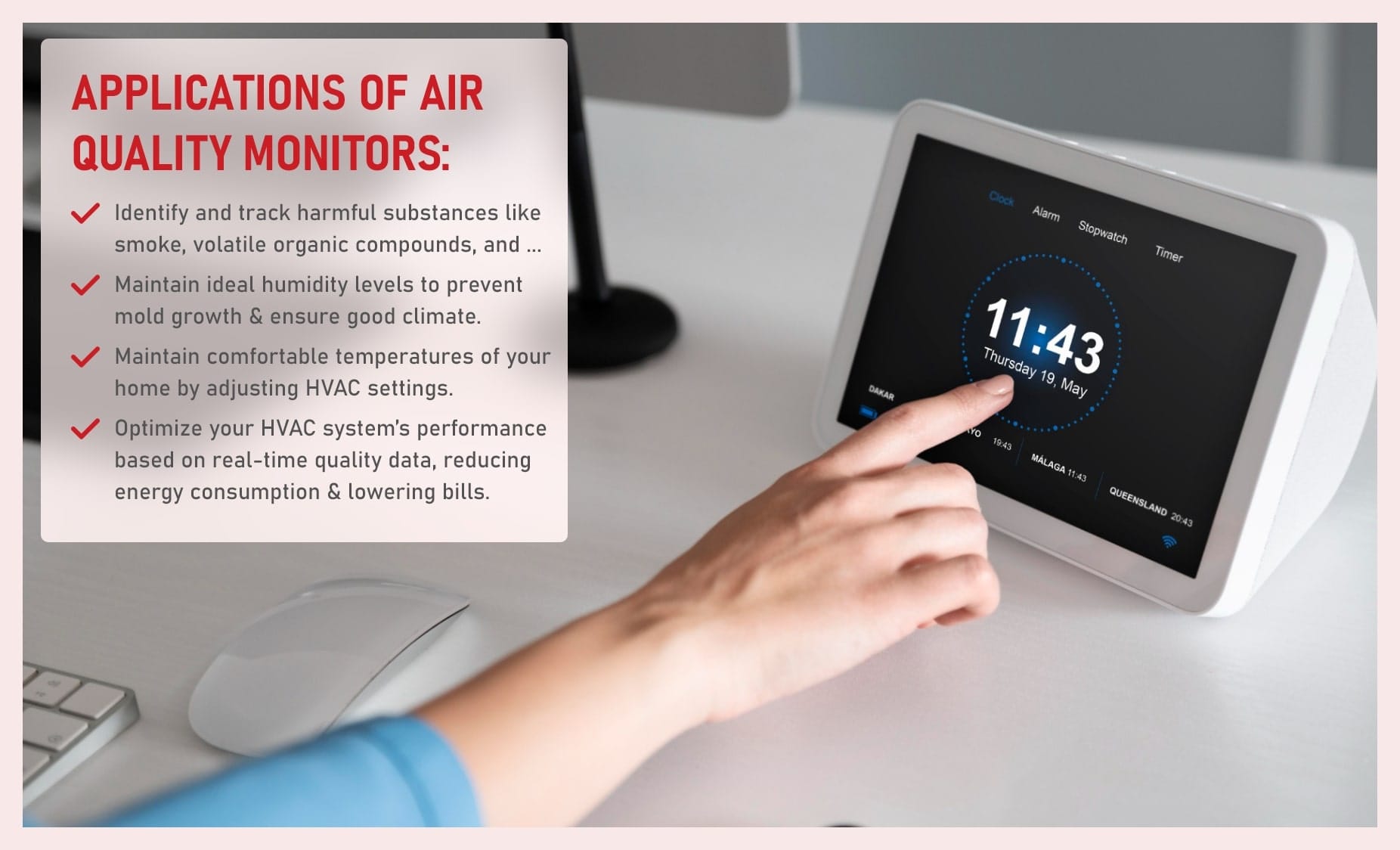
Inside the Technology: How Air Quality Monitors Function
Air quality monitors are sophisticated devices designed to safeguard your home’s environment by detecting and analyzing various air pollutants. At Ideal Air Systems, we leverage the latest advancements in air quality monitoring to enhance your HVAC system’s performance, ensuring you and your family breathe the cleanest air possible.
Key Components of Air Quality Monitors
- Particulate Matter (PM) Sensors
- PM2.5 and PM10 Sensors: These sensors measure fine and coarse particulate matter in the air—particles smaller than 2.5 micrometers (PM2.5) and 10 micrometers (PM10). Prolonged exposure to these particles can adversely affect your health, making their detection crucial for maintaining a healthy home.
- Optical Sensors: Utilizing laser scattering technology, optical sensors accurately determine the concentration of particulate matter, providing real-time data on air quality.
- Beta Attenuation: This method measures the amount of beta radiation passing through particulate matter, offering precise concentration levels essential for comprehensive air quality assessments.
- Gas Sensors
- CO2 (Carbon Dioxide): Monitored using Non-Dispersive Infrared (NDIR) sensors, CO2 levels are critical for ensuring adequate ventilation and preventing drowsiness.
- CO (Carbon Monoxide): Detected with electrochemical sensors, carbon monoxide is a dangerous gas that requires immediate attention to prevent health risks.
- NO2 (Nitrogen Dioxide): Measured using electrochemical or metal oxide semiconductor (MOS) sensors, NO2 is a common pollutant that can cause respiratory issues.
- O3 (Ozone): Ozone levels are tracked with electrochemical sensors to protect against respiratory irritation and other health concerns.
- SO2 (Sulfur Dioxide): Detected using electrochemical sensors, sulfur dioxide monitoring helps in managing indoor air quality effectively.
- VOC (Volatile Organic Compounds): Often identified with MOS sensors or photoionization detectors (PID), VOCs are emitted from various household products and can impact health.
- NH3 (Ammonia): Ammonia levels are monitored using electrochemical sensors to ensure a safe and comfortable indoor environment.
- Temperature and Humidity Sensors
- Temperature Sensor: Accurately measures ambient temperature, providing essential data for interpreting overall air quality and ensuring thermal comfort.
- Humidity Sensor: Monitors relative humidity levels, which can influence the effectiveness of particulate and gas sensors while preventing mold growth and maintaining comfort.
- Pressure Sensors
- Barometric Pressure Sensor: Measures atmospheric pressure, a factor that affects pollutant dispersion and the performance of various sensors, ensuring accurate air quality readings.
- Light Sensors (for Optical Detection)
- Photodiodes or Photodetectors: These sensors use light-based methods, such as laser scattering or light absorption, to detect and quantify particulate matter in the air, enhancing the accuracy of air quality assessments.
- Microcontroller or Processor
- The Brain of the Monitor: This component processes data from all sensors, performs necessary calculations, and manages communication with displays or wireless networks, ensuring seamless operation and real-time monitoring.
- Display (Optional)
- LCD or LED Screen: Provides users with instant access to real-time readings of pollutants, temperature, humidity, and trend data, making it easy to stay informed about your indoor air quality.
- Connectivity Modules (Optional)
- Wi-Fi/Bluetooth: Enables data transmission to smartphone apps, cloud services, or central systems, allowing for remote monitoring and control.
- GSM/Cellular: Facilitates remote data collection and transmission, ideal for extensive or dispersed environments.
- Ethernet: Offers reliable wired connections, commonly used in industrial or research settings for consistent data flow.
- Power Supply
- Battery: Ensures portability and uninterrupted operation in portable models.
- AC Adapter: Provides a stable power source for stationary or industrial monitors.
- Solar Panel: Utilized in outdoor or environmentally-focused monitors to harness renewable energy, promoting sustainability.
- Enclosure/Body
- Durable Casing: Typically made from high-quality plastic or metal, the enclosure protects internal components from environmental factors, ensuring longevity and reliability.
- Calibration and Compensation Features
- Automatic Calibration: Advanced monitors include self-calibration features to maintain accuracy over time.
- Environmental Compensation: Adjusts sensor readings based on temperature and humidity variations, ensuring precise air quality measurements regardless of changing conditions.
Seamless Integration with Your HVAC System
Air quality monitors from Ideal Air Systems can be effortlessly integrated into your existing HVAC setup, acting as intelligent feedback sensors. This integration allows your HVAC system to automatically adjust settings for optimal comfort and efficiency based on real-time air quality data. By doing so, you not only enhance indoor air quality but also maximize energy efficiency, reducing utility costs and minimizing environmental impact.

Essential for Comfort: The Role of Air Quality Monitors in Your HVAC System
Imagine walking into your home and knowing that every breath you take is as fresh and clean as the outdoors. Air Quality Monitors make this a reality by playing a pivotal role in your home’s HVAC system. At Ideal Air Systems, we understand that maintaining optimal air quality is essential for your comfort and health. Integrating an air quality monitor with your HVAC system ensures that your indoor environment is not only comfortable but also safe and energy-efficient. Here’s why investing in an air quality monitor is a smart choice for your home in the Greater Toronto Area.
1. Improving Health and Well-Being
Clean air is fundamental to your health. Air quality monitors detect harmful pollutants such as dust, pollen, and volatile organic compounds (VOCs), helping to reduce the risk of respiratory issues, allergies, and other health problems. By continuously monitoring and controlling air quality, these devices create a healthier living environment for you and your family.
2. Enhanced Comfort
Achieving the perfect indoor climate is easier with an air quality monitor. By regulating temperature and humidity levels, these monitors ensure that your home remains comfortable throughout the year. Whether it’s keeping your home cool in the summer or warm in the winter, maintaining optimal air quality directly contributes to your overall comfort.
3. Energy Efficiency
Energy efficiency is not only good for the environment but also for your wallet. Air quality monitors optimize your HVAC system’s performance by providing real-time data that allows for precise adjustments. This ensures that your system operates only when necessary, reducing energy consumption and lowering your utility bills.
4. Alerting Dangers
Safety is paramount in any home. Air quality monitors serve as an early warning system by detecting dangerous levels of carbon monoxide (CO), carbon dioxide (CO₂), and other hazardous gases. Immediate alerts allow you to take swift action, preventing potential health risks and ensuring the safety of your household.
5. Preventing Mold Growth
High humidity levels can lead to mold growth, which poses serious health risks and can damage your home. Air quality monitors keep humidity levels in check, preventing the conditions that allow mold to thrive. This not only protects your health but also preserves the integrity of your home’s structure and furnishings.
6. Increased Property Value
A home equipped with advanced air quality monitoring systems is more attractive to potential buyers. Demonstrating a commitment to health, comfort, and energy efficiency can significantly boost your property’s market value. Investing in an air quality monitor is not just beneficial for your current living conditions but also a smart investment for the future.
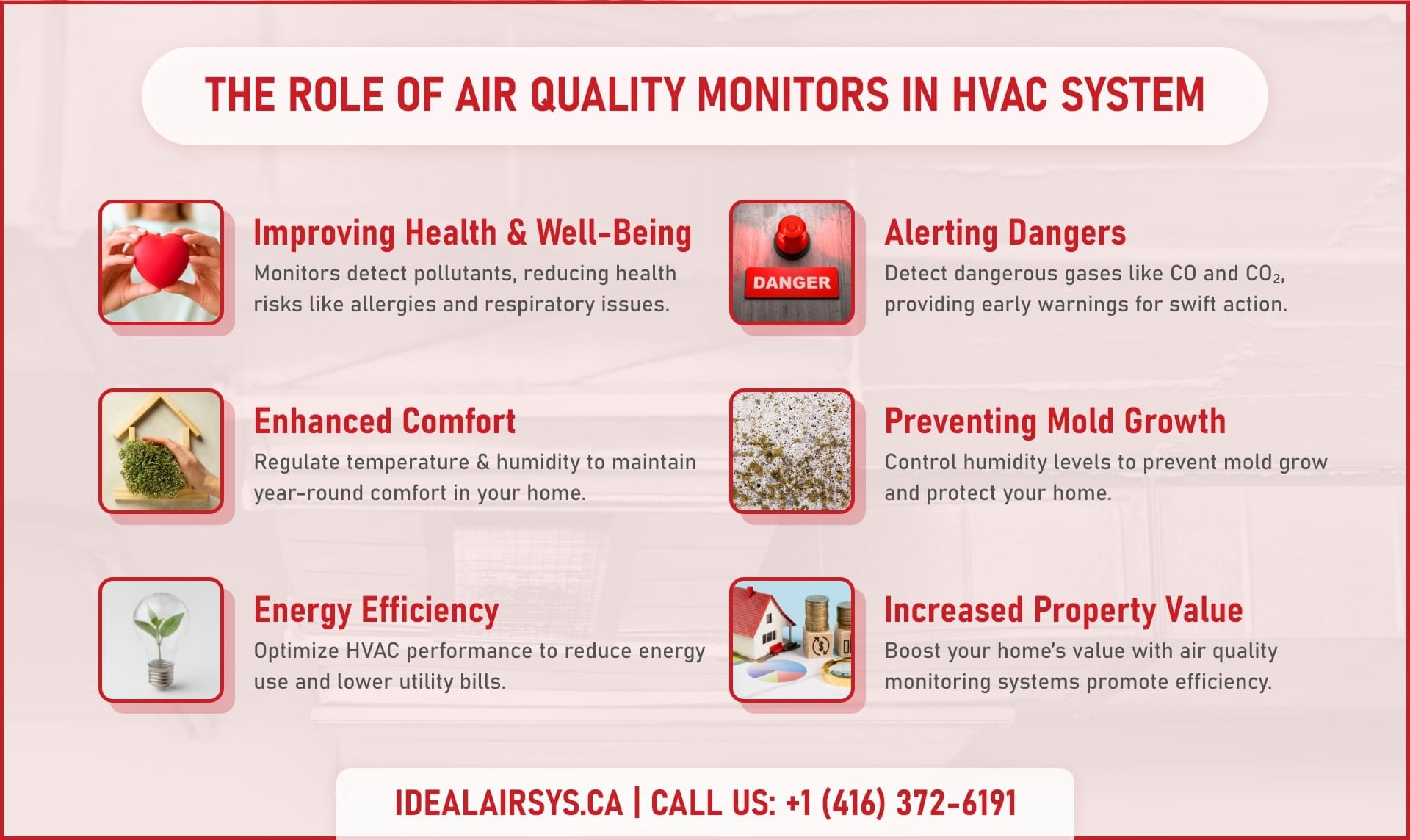
By incorporating an Air Quality Monitor into your HVAC system, you’re taking a proactive step towards a healthier, more comfortable, and energy-efficient home. Ideal Air Systems is dedicated to helping homeowners in Toronto, Markham, Richmond Hill, Vaughan, Newmarket, and the entire GTA achieve the best indoor air quality. Embrace the benefits of air quality monitoring and experience unparalleled comfort and peace of mind all year round.
Maximize Energy Efficiency: How Air Quality Monitors Optimize Your HVAC
Imagine reducing your energy bills while maintaining a comfortable and healthy home environment. Air Quality Monitors make this possible by optimizing your HVAC system’s performance, ensuring maximum energy efficiency without compromising on comfort.
Smart Ventilation for Optimal Efficiency
Monitoring air quality helps you understand when your HVAC system needs to ventilate more or less, improving overall energy efficiency. Air quality monitors continuously assess the levels of pollutants, temperature, and humidity in your home. This real-time data allows your HVAC system to make informed decisions about when to increase or decrease ventilation. By only ventilating when necessary, your system uses energy more efficiently, reducing unnecessary heating or cooling cycles and lowering your energy consumption.
Preventing Strain and Reducing Energy Consumption
By tracking air quality, the system can adjust air circulation to avoid strain on the HVAC unit, preventing breakdowns and reducing energy consumption. When your HVAC system operates under optimal conditions, it doesn’t have to work as hard to maintain your desired indoor climate. Air quality monitors provide the essential feedback needed to fine-tune airflow and temperature settings, ensuring that your HVAC unit runs smoothly and efficiently. This not only extends the lifespan of your equipment by preventing overuse and potential breakdowns but also significantly cuts down on energy costs.
Explore Your Options: Types of Air Quality Monitors for Every Need
When it comes to maintaining optimal air quality in your home, choosing the right Air Quality Monitor is essential. Air Quality Monitors are categorized based on their placement and specific applications, ensuring that every environment has the perfect solution for monitoring and improving air quality.
1. Indoor Air Quality Monitors
Indoor Air Quality Monitors are designed specifically for monitoring the air within your home. These monitors track various pollutants such as particulate matter (PM2.5 and PM10), carbon dioxide (CO₂), volatile organic compounds (VOCs), and humidity levels. By providing real-time data, indoor air quality monitors help you maintain a healthy and comfortable living environment. They seamlessly integrate with your HVAC system to adjust ventilation and filtration settings, ensuring that your indoor air remains clean and safe for you and your family.
2. Outdoor Air Quality Monitors
Outdoor Air Quality Monitors are built to withstand the elements and provide accurate measurements of outdoor pollutants. These monitors measure factors like ozone (O₃), nitrogen dioxide (NO₂), sulfur dioxide (SO₂), and particulate matter in the open air. Ideal for homes with extensive outdoor spaces or for those who want to stay informed about the air quality in their neighborhood, outdoor monitors help you make informed decisions about outdoor activities and enhance your overall living experience by understanding the external air conditions that affect your indoor environment.
3. Portable Air Quality Monitors
Portable Air Quality Monitors offer flexibility and convenience for those who need to monitor air quality in multiple locations. These compact and lightweight devices are perfect for taking with you on the go, whether you’re moving between different rooms in your home, traveling, or spending time in various environments. Portable monitors provide instant readings of key air quality indicators, allowing you to ensure that the air remains clean and safe wherever you are. Their versatility makes them an excellent choice for dynamic lifestyles and multi-purpose use.

While each type of air quality monitor serves a unique purpose, Indoor Air Quality Monitors are the cornerstone of creating a healthy and comfortable home environment. In this article, we will concentrate on indoor monitors, delving deeper into how they integrate with your HVAC system, the benefits they offer, and our top recommendations for the best indoor air quality monitors in 2025. By focusing on indoor solutions, We ensures that you receive the most relevant and actionable information to enhance your home’s air quality effectively.
Choosing the Perfect Air Quality Monitor: Key Factors to Consider
Selecting the right air quality monitor involves considering several crucial factors to ensure it aligns with your specific needs and environmental conditions. At Ideal Air Systems, we guide homeowners across Toronto, Markham, Richmond Hill, Vaughan, Newmarket, and the entire GTA in making informed decisions to achieve optimal indoor air quality. Here are the key factors to consider when choosing the perfect air quality monitor for your home:
1. Comprehensive Sensor Suite
Ensure your air quality monitor is equipped with essential sensors that detect a wide range of pollutants. Look for devices that measure particulate matter (PM2.5 and PM10), carbon dioxide (CO₂), volatile organic compounds (VOCs), and other harmful gases. A comprehensive sensor suite provides a complete picture of your indoor air quality, allowing your HVAC system to respond effectively.
2. High Measurement Accuracy
Accuracy is paramount when monitoring air quality. Choose monitors with proven high-precision sensors that deliver reliable data. Accurate measurements enable your HVAC system to make precise adjustments, ensuring your home remains comfortable and safe from harmful pollutants.
3. Advanced Features and Customization
Modern air quality monitors come with a variety of features such as real-time alerts, data logging, and trend analysis. Look for options that allow you to customize settings based on your specific needs. Advanced features enhance the functionality of your HVAC system, providing a smarter and more responsive home environment.
4. User-Friendly Interface
A user-friendly interface makes it easy to monitor and manage your indoor air quality. Opt for monitors with clear displays, intuitive controls, and easy-to-navigate menus. Simplifying the user experience ensures you can effortlessly keep track of your air quality and make necessary adjustments.
5. Reliable Power Options
Consider the power supply options of the air quality monitor. Devices with long-lasting internal batteries or reliable AC adapters ensure continuous operation without frequent interruptions. Reliable power options are essential for maintaining consistent air quality monitoring.
6. Seamless Wireless Connectivity
Wireless connectivity features such as Wi-Fi and Bluetooth enable seamless integration with your smartphone or smart home systems. This allows you to monitor air quality remotely, receive instant notifications, and control your HVAC system from anywhere, enhancing convenience and responsiveness.
7. Durable Design and Quality Build
Invest in an air quality monitor with a sturdy design and high-quality build materials. A durable monitor ensures longevity and consistent performance, even in varying indoor conditions. A well-built device is a reliable addition to your HVAC system, providing accurate data year after year.
8. Effective Indicators and Alarms
Choose monitors equipped with clear indicators and audible alarms to alert you of any air quality issues immediately. Effective alarms ensure you can take prompt action to address potential hazards, maintaining a safe and healthy living environment for your family.
9. Cost-Effective Solutions
Evaluate the value for money when selecting an air quality monitor. Consider the initial cost, ongoing maintenance, and the long-term benefits of improved air quality and energy efficiency. A cost-effective solution provides excellent performance without breaking the bank, making it a smart investment for your home.
10. Easy Calibration and Maintenance
Opt for monitors that offer easy calibration and minimal maintenance requirements. Automatic calibration features ensure your device remains accurate over time, while simple maintenance procedures keep your monitor functioning optimally without hassle.

Get Expert Guidance Today
Choosing the perfect air quality monitor can significantly enhance your home’s HVAC system, ensuring a healthier and more comfortable living environment. If you need assistance in selecting the right air quality monitor for your home, our expert team at Ideal Air Systems is ready to provide a free consultation. Serving Toronto, Markham, Richmond Hill, Vaughan, Newmarket, and the entire GTA, we are dedicated to helping you achieve the best indoor air quality solutions tailored to your needs. Make an appointment today to breathe easier and live better with our professional HVAC services.
Top 4 Air Quality Monitors of 2025: Our Expert Recommendations
Choosing the right air quality monitor can be overwhelming with the myriad of options available in the market. At Ideal Air Systems, we’ve done the research for you to bring you the top 4 air quality monitors of 2025. These recommended devices offer exceptional performance, advanced features, and reliable accuracy to ensure your home in Toronto, Markham, Richmond Hill, Vaughan, Newmarket, and the broader GTA enjoys the best indoor air quality. Let’s explore our expert picks that cater to every need and budget.
1. Airthings Wave Plus
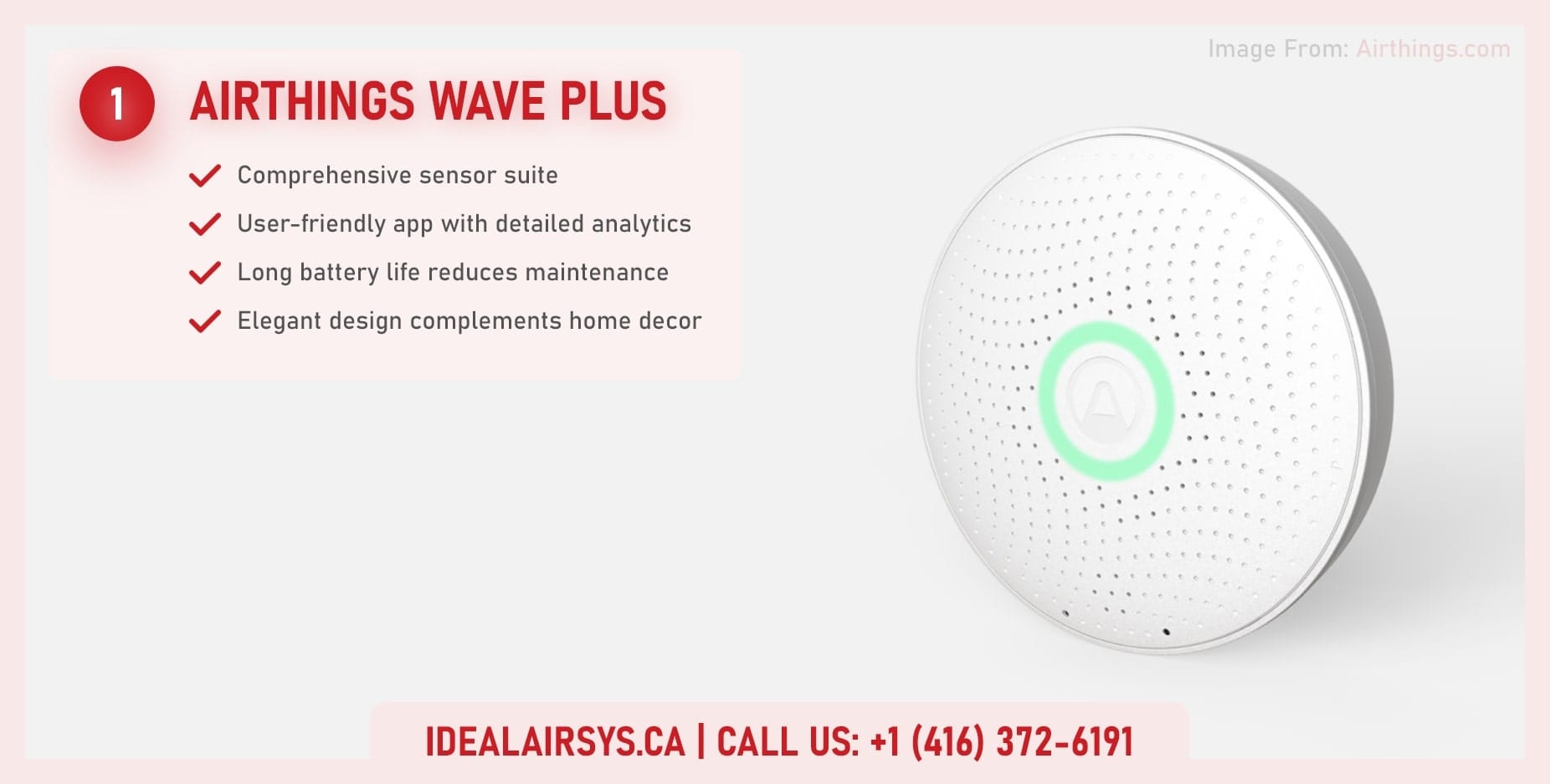
Airthings Wave Plus is a comprehensive indoor air quality monitor renowned for its accuracy and user-friendly interface. Perfect for homeowners seeking detailed insights into their indoor environment, this monitor seamlessly integrates with smart home systems to provide real-time data and alerts.
- Features:
- Measures Radon (Rn-222), CO2, VOCs, humidity, temperature, and air pressure
- Bluetooth connectivity for easy data access via smartphone app
- Long battery life with replaceable batteries
- Sleek and modern design
- Specifications:
- Connectivity: Bluetooth
- Power: 2 AA batteries (up to 2 years)
- Display: LED indicators
- Dimensions: 8.1 x 4.6 x 2.2 inches
- Pros:
- Comprehensive sensor suite
- User-friendly app with detailed analytics
- Long battery life reduces maintenance
- Elegant design complements any home decor
- Cons:
- Limited to Bluetooth connectivity, no Wi-Fi integration
- Higher price point compared to basic models
- Price Range: $150 – $200
Airthings Wave Plus is ideal for those who prioritize a wide range of pollutant detection and seamless integration with their smart home ecosystem.
2. IQAir AirVisual Pro

The IQAir AirVisual Pro stands out with its exceptional accuracy and real-time outdoor air quality data integration. It’s perfect for homeowners who want to monitor both indoor and outdoor air quality to make informed decisions about their HVAC system’s performance.
- Features:
- Measures PM2.5, CO2, temperature, and humidity
- Dual sensors for indoor and outdoor air quality
- Wi-Fi connectivity for real-time updates and cloud data storage
- Color-coded display for easy interpretation
- Specifications:
- Connectivity: Wi-Fi
- Power: AC adapter
- Display: LCD screen
- Dimensions: 7.6 x 5.5 x 2.5 inches
- Pros:
- High accuracy and reliability
- Real-time outdoor air quality data
- Easy-to-read display with color indicators
- Robust mobile app with historical data tracking
- Cons:
- Requires constant power supply, limiting portability
- More expensive than some competitors
- Price Range: $200 – $250
IQAir AirVisual Pro is perfect for those who need precise indoor and outdoor air quality monitoring with advanced connectivity features.
3. Qingping AQM Gen2

The Qingping AQM Gen2 offers a balanced mix of functionality and affordability, making it a popular choice among homeowners looking for reliable air quality monitoring without breaking the bank. Its compact design and essential features make it a versatile addition to any home.
- Features:
- Measures PM2.5, VOCs, temperature, and humidity
- Bluetooth connectivity for mobile app access
- Portable and lightweight design
- Silent operation with no intrusive sounds
- Specifications:
- Connectivity: Bluetooth
- Power: Rechargeable battery
- Display: LED indicators
- Dimensions: 6.3 x 3.5 x 1.9 inches
- Pros:
- Affordable pricing
- Portable and easy to move around
- Quiet operation suitable for all rooms
- User-friendly mobile app
- Cons:
- Limited sensor range compared to premium models
- Shorter battery life requires more frequent charging
- Price Range: $80 – $120
Qingping AQM Gen2 is an excellent option for budget-conscious homeowners who need a reliable and portable air quality monitor for everyday use.
4. IKEA Vindstyrka

The IKEA Vindstyrka combines functionality with stylish Scandinavian design, making it a favorite among design-conscious homeowners. This monitor not only tracks essential air quality metrics but also blends seamlessly with modern home interiors.
- Features:
- Measures PM2.5, VOCs, temperature, and humidity
- Bluetooth connectivity with smartphone integration
- Minimalist design with customizable display options
- Energy-efficient operation
- Specifications:
- Connectivity: Bluetooth
- Power: Replaceable batteries
- Display: LED indicators with customizable lighting
- Dimensions: 5.9 x 4.1 x 1.7 inches
- Pros:
- Stylish and minimalist design
- Customizable display options to match home decor
- Energy-efficient with long battery life
- Easy setup and integration with IKEA smart home products
- Cons:
- Limited advanced features compared to higher-end models
- Bluetooth-only connectivity may not suit all users
- Price Range: $100 – $150
IKEA Vindstyrka is perfect for homeowners who value aesthetics and want an air quality monitor that complements their modern home design while providing essential air quality insights. Below you can see a summary information about this 4 air quality monitors in a table.
| # | Airthings Wave Plus | IQAir AirVisual Pro | Qingping AQM Gen2 | IKEA Vindstyrka |
| Manufacturer Company | Airthings | IQAir | Qingping | IKEA |
| Brief Description | A smart air quality monitor that tracks a wide range of pollutants and provides real-time feedback. | Advanced air quality monitor with a large display, measuring PM2.5, CO2, and more. | Affordable yet effective air quality monitor with smart features. | Affordable, minimalist air quality monitor for home use. |
| Features | Measures radon, CO2, VOCs, temperature, humidity, and pressure. | Measures PM2.5, CO2, temperature, humidity, and PM10. | Measures PM2.5, temperature, humidity, CO2, and VOCs. | Measures CO2, VOCs, temperature, humidity, and PM2.5. |
| Battery Life | Up to 2 years (with batteries) | AC-powered (no battery) | Rechargeable battery, up to 8-12 hours | 2x AA batteries (battery life not specified) |
| Operating Temperature | 0°C to 50°C (32°F to 122°F) | 0°C to 50°C (32°F to 122°F) | 0°C to 50°C (32°F to 122°F) | 0°C to 40°C (32°F to 104°F) |
| Dimensions | 18.2 x 8.5 x 2.5 cm | 18.5 x 18.5 x 4.8 cm | 8.1 x 8.1 x 2.5 cm | 12 x 6.5 x 3.5 cm |
| Advantages | Radon detection Long battery life Smart app integration | Large, clear display Measures PM2.5, CO2, VOCs Detailed air quality data | Affordable Compact design Smart features | Affordable Sleek, minimalist design |
| Dis-Advantage | Expensive Limited battery life if used in continuous mode | No battery option, must be plugged in High price | May lack some advanced features Limited app functionality | Limited data points No app integration |
| Price Range | $250 – $350 | $300 – $400 | $60 – $100 | $60 – $80 |
The Future of Clean Air: AI Innovations in Air Quality Monitoring
Artificial Intelligence (AI) is set to revolutionize every aspect of our lives, and the HVAC industry is no exception. We are excited to embrace AI advancements that are transforming air quality monitors and HVAC systems, making your home smarter and healthier than ever before.
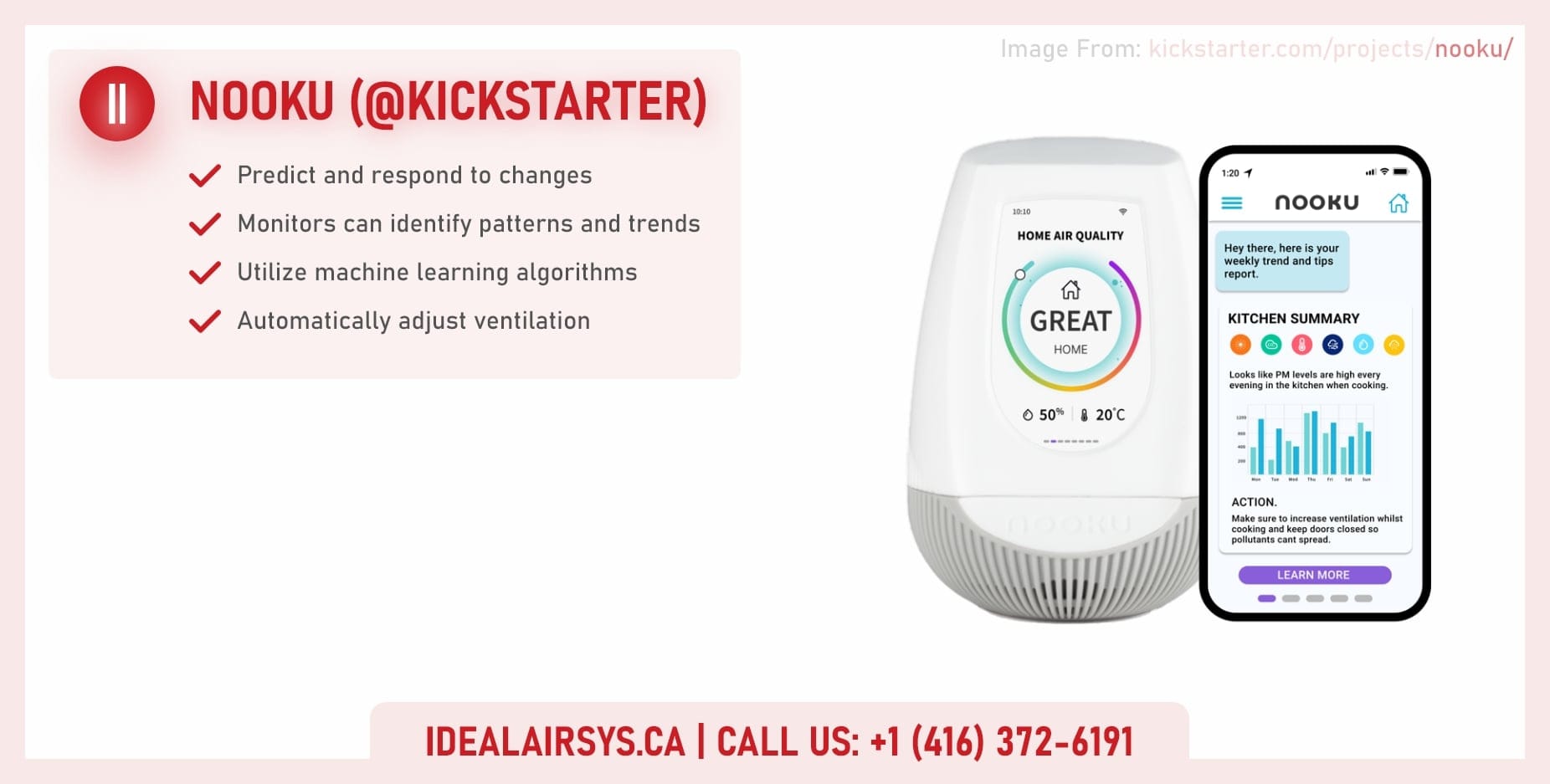
AI technology brings unprecedented intelligence and automation to HVAC systems and air quality monitors. By analyzing vast amounts of data in real-time, AI can predict and respond to changes in indoor air quality with remarkable precision. This means your HVAC system can automatically adjust ventilation, temperature, and humidity levels to maintain optimal comfort and efficiency without manual intervention. Additionally, AI-powered air quality monitors can identify patterns and trends, providing deeper insights into your home’s air quality and enabling proactive maintenance to prevent issues before they arise.
One exciting example of AI innovation in air quality monitoring is the latest AI-based monitors featured in recent advancements. These monitors utilize machine learning algorithms to continuously improve their accuracy and responsiveness. They can differentiate between various pollutants more effectively, provide personalized air quality recommendations, and integrate seamlessly with smart home ecosystems for a fully automated living environment.
Your Air Quality Questions Answered: FAQs
At Ideal Air Systems, we understand that maintaining excellent indoor air quality is essential for your health and comfort. To help you make informed decisions, we’ve compiled answers to the most frequently asked questions about air quality monitors. Whether you’re in Toronto, Markham, Richmond Hill, Vaughan, Newmarket, or anywhere in the GTA, our expert team is here to guide you.
1. What is an Indoor Air Quality (IAQ) Monitor?
An indoor air quality (IAQ) monitor is a device that measures and tracks various pollutants and environmental conditions inside your home. It detects contaminants like volatile organic compounds (VOCs), carbon dioxide (CO₂), particulate matter (PM2.5 and PM10), humidity, temperature, radon, and carbon monoxide (CO). IAQ monitors provide real-time data to help you maintain a healthier indoor environment.
2. Why Should I Monitor Indoor Air Quality?
Monitoring indoor air quality is vital because poor air quality can lead to health issues such as respiratory problems, allergies, and headaches. By keeping an eye on IAQ, you can identify pollutant sources, track air quality trends, and implement strategies to improve the air you breathe, ensuring a healthier and more comfortable living space.
3. What Pollutants Do IAQ Monitors Detect?
IAQ monitors can detect a variety of pollutants depending on their sensors. Common pollutants include:
- VOCs from cleaning products and furnishings
- CO₂ from respiration and combustion
- PM2.5 and PM10 from dust and smoke
- Radon, a radioactive gas from soil and building materials
- Ozone (O₃) from air purifiers and outdoor sources
- Nitrogen Dioxide (NO₂) from combustion processes
- Carbon Monoxide (CO) from incomplete combustion
4. Where Should I Place an IAQ Monitor?
For accurate readings, place your IAQ monitor in rooms where you spend the most time, such as living rooms, bedrooms, or home offices. Avoid areas near heat sources, direct sunlight, or obstructed airflow. Positioning the monitor at breathing height (around chest level) and away from walls or corners ensures representative air quality measurements.
5. How Often Should I Calibrate My IAQ Monitor?
Calibration frequency varies by manufacturer and sensor type. Generally, IAQ monitors should be calibrated annually by professionals to maintain accuracy, especially for sensors detecting gases like CO₂ or VOCs. Regular calibration ensures reliable measurements and adherence to industry standards.
6. Do IAQ Monitors Require Maintenance?
Yes, IAQ monitors need regular maintenance to function accurately. This includes cleaning sensors to remove dust and debris, replacing filters if applicable, and checking the power source (batteries or power supply). Follow the manufacturer’s maintenance guidelines to ensure consistent performance and longevity of your monitor.
7. Can IAQ Monitors Detect Mold or Allergens?
While IAQ monitors don’t directly measure specific allergens like mold spores or pollen, they can indicate poor air quality conditions that may support mold growth or increased allergens. Elevated levels of certain pollutants can suggest environments conducive to allergens, helping you take steps to improve air quality for allergy-sensitive individuals.
8. How Accurate Are Air Quality Monitors?
The accuracy of air quality monitors depends on the sensor technology, calibration, and environmental conditions. High-quality monitors with regular calibration provide reliable readings. Factors such as temperature, humidity, and proper sensor placement also influence accuracy.
9. Can Air Quality Monitors Detect All Types of Pollutants?
Air quality monitors are designed to detect specific pollutants based on their sensors. While some monitors specialize in gases (like CO, CO₂, NO₂) or particulate matter (PM2.5, PM10), advanced models can detect a broader range of pollutants. Choose a monitor that matches your specific air quality needs.
10. How Long Do Air Quality Sensors Last?
The lifespan of air quality sensors varies by type and usage but typically ranges from one to several years. Regular maintenance and following manufacturer guidelines can extend sensor longevity, ensuring your monitor continues to provide accurate data.
11. Do Air Quality Monitors Need Calibration?
Yes, calibration is essential to maintain the accuracy of air quality monitors. Regular calibration ensures precise pollutant detection and reliable measurements. Some monitors feature automatic calibration, while others may require manual recalibration based on usage and manufacturer recommendations.
12. What Are the Benefits of Integrating an IAQ Monitor with My HVAC System?
Integrating an IAQ monitor with your HVAC system allows for real-time adjustments to ventilation, temperature, and humidity levels based on air quality data. This integration enhances energy efficiency, prevents HVAC strain, and ensures a consistently comfortable and healthy indoor environment.
Breathe Better with Ideal Air Systems: Conclusion
At Ideal Air Systems, we’ve demonstrated how advanced air quality monitors can transform your HVAC system, ensuring a healthier, more comfortable home while boosting energy efficiency. From understanding the essential technologies and selecting the right monitor to exploring future AI innovations, investing in quality air monitoring is a smart choice for homeowners in Toronto, Markham, Richmond Hill, Vaughan, Newmarket, and the entire GTA. Ready to enhance your indoor air quality and enjoy optimal comfort year-round? Contact us today for a free consultation and let our professional team provide you with the best HVAC and air quality solutions tailored to your needs.

